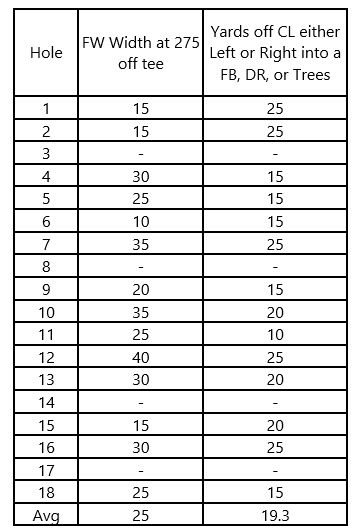The following is a “reprint” from a post that originally appeared on the APBA Between the Lines forum.
Armed with the Game Caddie to speed up play and its accompanying database tool to keep track of all the stats the caddie provides, I thought fellow APBA golfers might appreciate a data-driven review of a few courses. Since I am a big fan of APBA’s Master Game rules, these data reflect their use.
This post focuses on Empire (Bethpage Black). APBA has Empire playing as a par 70, which is what the 2009 US Open played it as, by converting the 525-yard No. 7 into a par 4 from a par 5. In 2009, Empire played at 7428 yards, which is a very long par 70. Regulars playing from the Blue tees, face a course with a par of 71 with course/slope ratings of 77.5/155 (USGA). That rating combination indicates that Empire is one of golf’s toughest tests–and it is a public course. Some reviewers rate it as the most difficult on the tour.
Narrow fairways with trouble at the edges
Water is not the challenge on this course. What makes it difficult is its length in combination with trouble on one or more sides of its narrow fairways. “Trouble” in this case is primarily deep rough and trees, both of which kill distance on the shot taken and restrict distance on the next shot as well. It has plenty of bunkers close to the edge of many fairways that kill roll, too.
The table below shows one way to think about how tight this course plays. For example, for par 4s and 5s at 275 yards off the tee, the average fairway width is 25 yards. That’s from the left edge of the fairway to the right edge. A shot that is on average 20 yards off the centerline, either left or right in the wrong direction, may easily encounter a fairway bunker, trees or deep rough. Of these, the deep rough is usually the greatest distance killer in that the player is always restricted to a maximum club of a PW on the next shot. Suffice it to say, Empire has an abundance of deep rough!

Pin-hunting is often ill-advised or not an option
The greens are straight-forward and hole notes are kept to a minimum. Thus, play is fast and decision-making uncluttered. Many pins are set at less than one full square from the edge of the green, thereby effectively reducing the green’s playable size. The length of the course and the ample size of most of the greens makes pin-hunting risky on approaches. A slightly errant shot can leave a short-side chip back to the CL–and result in an almost certain short-game bogey. Green-side bunkers abound, so sand traps become a factor when pin-hunting as well.
How Empire has played for me
All that said, I love this course. It rewards players that can keep the ball in play and those who can get up and down. In general, FWs hit (54.2%) and GIRs (50.6%) are down from other APBA courses I have played, and the group average is about one-and-a-half strokes over par (71.4) after 36 rounds. Holes 9 and 10, both long par 4s, have been the most difficult. What I’ve found on Empire is that while a booming drive on a long par 4 is generally good, one on the fairway is even better.
Average stats per round are shown below.
I’ve been playing APBA Golf for a year now and didn’t enjoy it until I found Game Caddie. I started with GC 2.5 and I am so happy with all of the new features. The all in one button is a game changer. Makes tournament play a breeze (moderate or blustery). Thank you for the great product called Game Caddie 4.0.